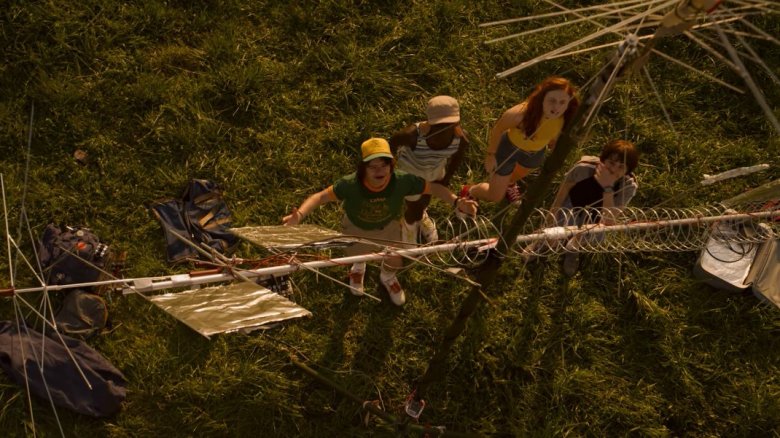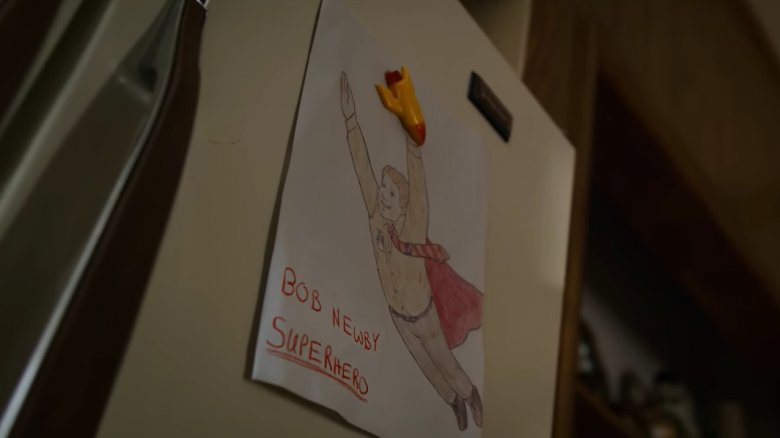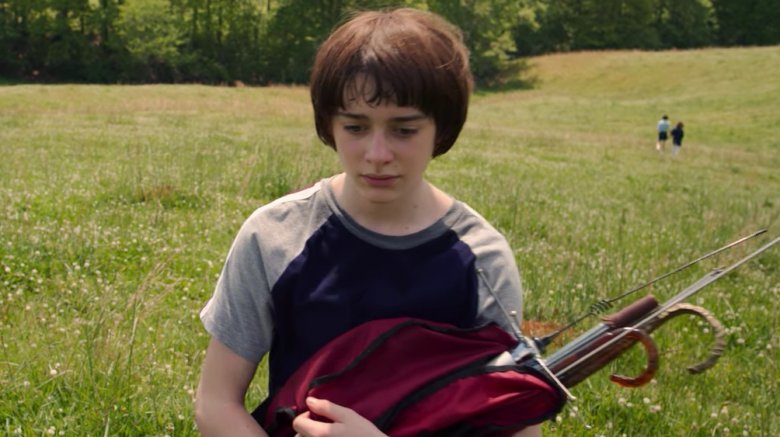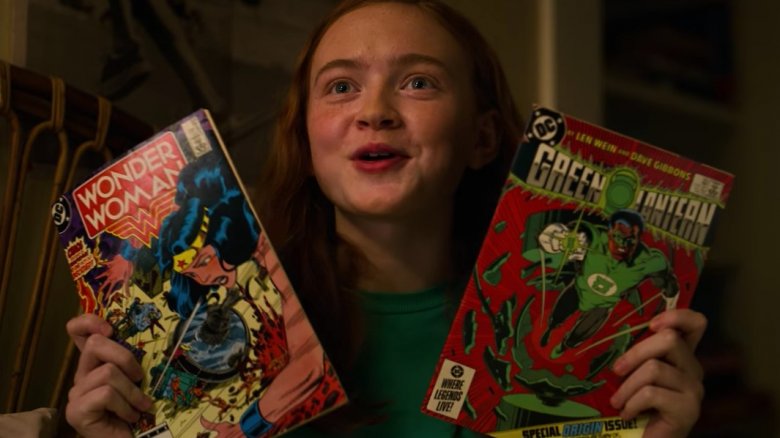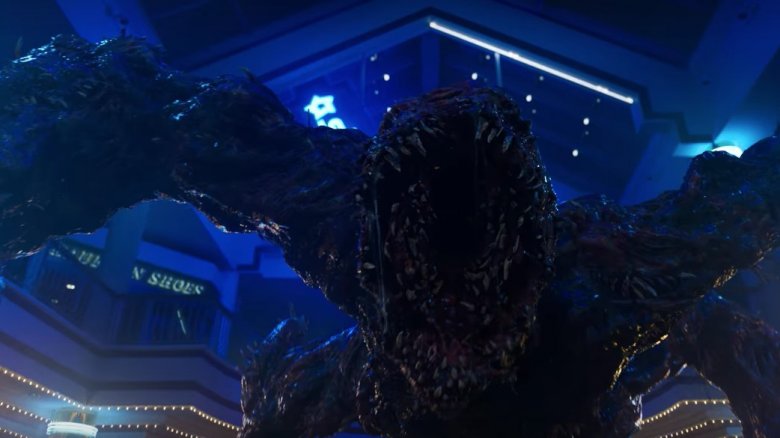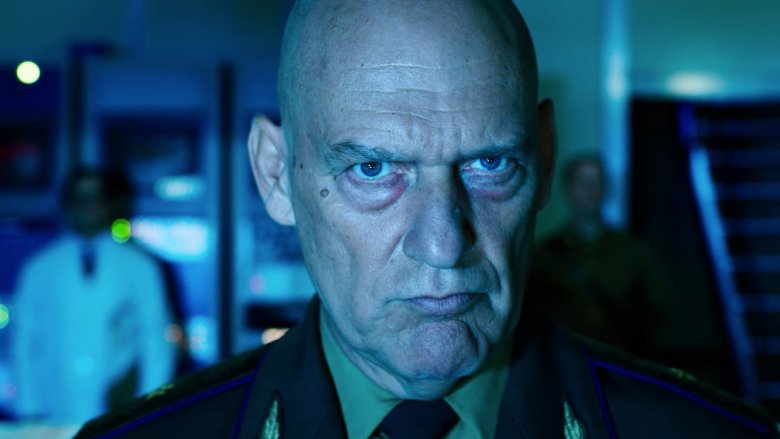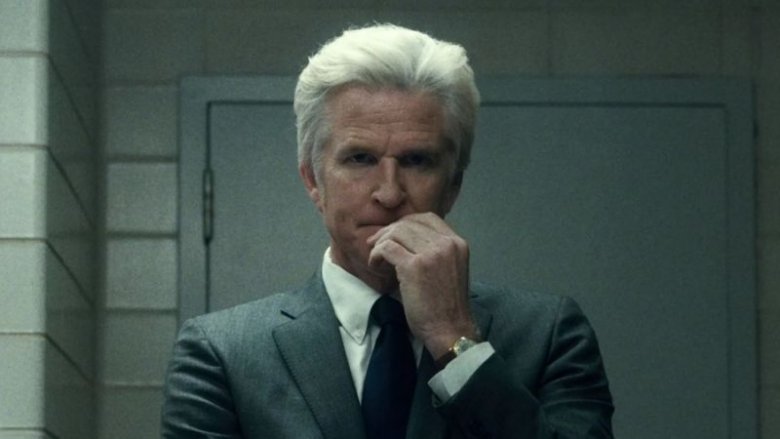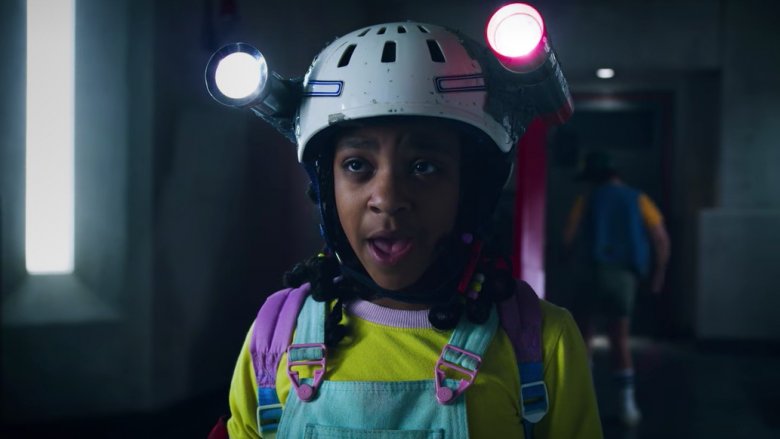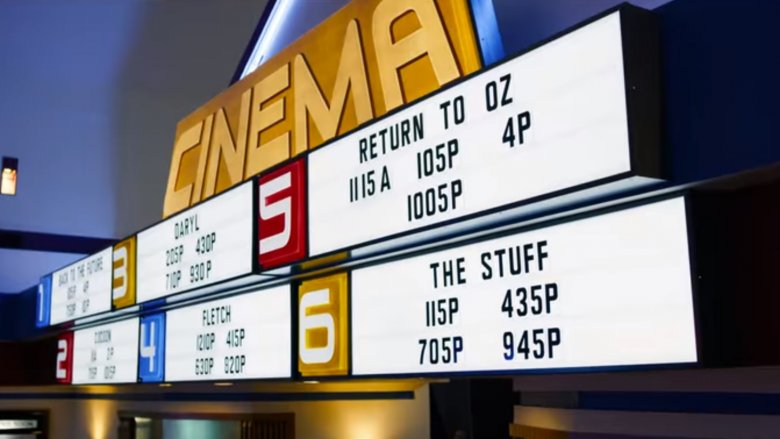Small Details You Missed In Stranger Things 3
Stranger Things 3 is finally here — and with it comes the Red Army, parasitic sludge monsters, and more '80s references than you can shake an ice cream scooper at.
The first two seasons of the hit Netflix show gave Stranger Things a reputation for — among other things — painstakingly recreating the era of the '80s. The clothing, the music, the hairstyles, and the posters on the characters' bedroom walls all hearken back to a time when Orange Julius ruled America's shopping malls, you could still smoke just about anywhere you wanted, and MTV actually showed music videos. As it was with the series' first two seasons, there are tons of '80s details to catch in Stranger Things 3.
Of course, '80s nostalgia isn't the only thing you can find if you dig a little deeper. There are subtle references to earlier seasons, some of which may have a huge impact on what's to come. Also, like the best horror films, the supernatural and science fiction elements of Stranger Things 3 aren't just scary and cool to look at — they work as poignant metaphors for what's going on in the characters' world.
For specifics, keep reading to learn about some of the small details you may have missed in Stranger Things 3. And, obviously, major spoilers ahead.
Stranger Things 3 gives us Cerebro, minus the Professor
One of the earliest pop culture references in Stranger Things 3 comes with Dustin's (Gaten Matarazzo) return to Hawkins. Dustin thinks his friends have forgotten him when he gets home, but the gang surprises him — much to Lucas' (Caleb McLaughlin) dismay when Dustin is so shocked he sprays something unhealthy right in his friend's eyes.
Dustin tells everyone about his new girlfriend Suzie (Gabriella Pizzolo), who seems to be a figment of Dustin's imagination before we finally meet her in the season finale, along with getting to hear the disgustingly happy couple belt out the theme song to 1984's Neverending Story. Dustin explains the only way to contact Suzie is his newly constructed ham radio, which he nicknames "Cerebro."
Anyone familiar with Marvel's X-Men from just about any medium will know where Dustin gets the name. Cerebro is the device Professor X uses to amplify his telepathic powers to find other super-powered mutants.
With her psychic abilities, Eleven (Millie Bobby Brown) is the character in Stranger Things most like Professor X, and ironically she's one of the few of the series' kids who isn't there for Cerebro's unveiling. Dustin gets everyone to agree to hike with him to Hawkins' tallest hill so they can set up Cerebro and contact Suzie, but Eleven and Mike (Finn Wolfhard) bail before they finish the climb, presumably to find a good spot to make out.
The metaphor of demagnetism
In Stranger Things 3, Joyce (Winona Ryder) once again notices something that seems relatively minor to everyone else, but to her hints toward something worse on the horizon — and of course she's right. Both in her kitchen and at her job, Joyce takes note of instances when magnets abruptly stop working. In her kitchen, she finds all of her fridge magnets on the floor and the same thing happens when she's talking to Hopper (David Harbour) at her job. We eventually learn this de-magnetization is a side effect of the device the Soviets are using to re-open the gate to the Upside Down.
Symbolically, this de-magnetization impacts more than just Joyce's fridge. The things that attract the series' characters to one another begin to disappear as well. Hopper sees his relationship with Eleven threatened because of all the time she's spending with Mike, and Eleven eventually dumps Mike for lying. Nancy (Natalia Dyer) and Jonathan (Charlie Heaton) almost break up when they're fired from the local paper. Dustin feels betrayed by his friends when they refuse to wait with him to contact Suzie, and with everyone else coupled up Will (Noah Schnapp) feels abandoned. Steve (Joe Keery) can't get the girls to swoon over him anymore, and the rendezvous we saw coming at the end of last season between Billy (Dacre Montgomery) and Karen Wheeler (Cara Buono) is interrupted both by Karen's change of heart and the Mind Flayer.
Weathertop, minus the wraiths
Dustin's Cerebro ends up being a pop culture reference standing atop a pop culture reference. He doesn't use the name earlier when he leads his friends there, but in the season finale we learn Dustin has given a name to the hill where he keeps Cerebro — Weathertop. He says the name when Steve takes him and Erica (Priar Ferguson) to Cerebro, speaking it as if Steve should just naturally know what he means.
If your memory isn't that great or you're not a Tolkien fan — Weathertop is a ruin atop a hill in J.R.R. Tolkien's Fellowship of the Ring. Shortly after they meet one another, Aragorn and the hobbits camp there on their way to the Elven land of Rivendell. It's where the heroes are briefly surrounded by the Ring Wraiths, and where Frodo is stabbed in the arm by the Witch King of Angmor and corrupted by the undead warrior's blade.
Of course, Stranger Things 3 is set in 1985, and Peter Jackson's adaptation Lord of the Rings: The Fellowship of the Ring wouldn't be released for another 16 years. However, as not only a self-proclaimed nerd but a Dungeons & Dragons player, Dustin is definitely familiar with the books. Not to mention that even if he wasn't big on fantasy novels, he could be a fan of the 1978 animated Lord of the Rings film.
Will: Stranger Things 3's forgotten boy
Perhaps the cruelest irony of Stranger Things 3 is what happens to Will. It isn't just that everyone else's changing interests make him feel alone. For Will, the beginning of Stranger Things 3 is the polar opposite of what happens in the first season.
The first season of Stranger Things revolves around Will's disappearance. Almost all of that season's major characters are desperate to find Will and bring him back. Now, with two years gone and two battles fought and won, Will's friends hardly seem to notice him. Mike is focused on Eleven, Lucas is focused on Max (Sadie Sink), and Dustin is focused on the fact that no one is focused on him. To the same people who risked so much to find and save Will in the first season, he now seems practically invisible. When Lucas and Mike start hatching a plan to convince Eleven to take Mike back, they run out of the room and leave Will there, apparently ignoring him or not noticing as he yells after them. Really, it's kind of like Will is back in the Upside Down — he's sharing the same space as everyone else, but they can't hear him.
Max's comics
In the beginning of Stranger Things 3's fourth episode, "The Sauna Test," Max offers Eleven one of two comic books to read, and those specific issues seem to have been chosen for a few reasons. Most obviously, they're accurate for the time. Wonder Woman #326 was released in 1985 — the year in which Stranger Things 3 was set — while Green Lantern #185 came out in 1984.
Both comics end with the reveal of a villain reminiscent of the Mind Flayer. In Green Lantern #185, test pilot Richard Davis unwillingly flies a jet into a giant black column and inside he finds Eclipso — a mystically parasitic supervillain known for controlling and corrupting hosts, just like the Mind Flayer. Likewise, Wonder Woman #326 ends with the emergence of the Aztec god Tezcatlipoca who is described as, among other things, "the god of the nocturnal sky... the embodiment of change through conflict." Both concepts are powerfully present in Stranger Things 3, particularly the concept of change.
The Mind Flayer, the Mall, the Russians
Stranger Things 3 is set during a time of major tension between the United States and the Soviet Union, a conflict characterized, in part, by the clash between capitalism and communism. With the Mind Flayer, the makers of Stranger Things give us a monster meant to represent the excesses of both ideas.
In the beginning of the season, we learn Hawkins' local businesses are suffering because of the Starcourt Mall. Compared to the crowded mall — a symbolic example of capitalism's excesses — downtown Hawkins looks like a ghost town. From a certain point of view, the mall is destroying the same town it's built upon. The physical manifestation of the Mind Flayer is made from corrupting Hawkins' people, killing them, and absorbing their flesh into its massive form. Like the mall, the Flayer is made from the town it's killing.
At the same time, the Flayer also reflects the excesses of communism. The people the Flayer corrupts, enslaves, and eventually absorbs become separate pieces of a single body, which is why in the season finale Billy suffers every time the Flayer is attacked. The title of the sixth episode is "E pluribus unum," which is Latin for "Out of many, one," which is exactly how you could describe the Mind Flayer, or how someone might describe the stated goals of Communism. On the other hand, that exact phrase appears on most American currency, a symbol for capitalism if ever there was one.
The Russians and their intentions in Stranger Things 3
With everything that's going on in Stranger Things 3, you could be forgiven for overlooking the absence of a fairly basic piece of the puzzle. In spite of what must be an astronomical financial cost, in spite of all the people they lose, and in spite of the international incident they're risking by running their facility in the middle of the United States, we never learn just why the Russians want to re-open the gate to the Upside Down. We know what all the major characters know — that re-opening the gate is a really bad idea, but we never learn of any specific purpose.
And the gate is something they want re-opened soon. In the season's first cold open, a Russian scientist is murdered for failing to open the gate, and Dr. Alexei (Alec Utgoff) is told he has one year to succeed where his predecessor failed. We get the sense this might not be the first time one scientist got a deadline while watching another scientist get strangled Darth Vader style. This isn't just exploratory science — the Soviets want something, they want it yesterday, and they're willing to literally open the gates to hell to do it.
The American?
Hopefully, you didn't look away too early at the end of Stranger Things 3. That's because there's a mid-credits scene that will no doubt prove crucial to future episodes. Falling flakes interrupt the credits, making you think maybe we're about to see the Upside Down. Instead we go to a Soviet prison where two guards feed a prisoner to a captive Demogorgon. Right before they choose the prisoner, one guard heads towards a cell, and the second guard says "Not the American." So they move on to the next cell where they find the Demogorgon's snack.
Who is the American? Well, one possibility is Hopper, since we never see his body at the end of the finale. But since the US soldiers rush into the Soviet's sub-Starcourt facility right after the gate is sealed, it would seem strange — even if Hopper survived — that the Russians would have him. Not to mention it would raise the question of why he would get a free pass from becoming the Demogorgon's lunch.
No, the more likely candidate is Dr. Brenner (Matthew Modine). In spite of what seemed like a pretty conclusive death in the first season, in 2017 Stranger Things producers confirmed to Collider that Eleven's surrogate father is still alive. If the Russians have him, it would explain how they knew about the gate's location in Hawkins. And considering everything he knows, it would make sense why the Russians wouldn't want to waste him on a meal.
The cage Erica found in Stranger Things 3
In the sixth episode of Stranger Things 3, as Dustin and Erica try to find a way out of the Russians' underground base, Erica spots a large cage. She asks Dustin to remind her how large Demogorgons are, and he gives her the dimensions. For some reason, she doesn't say anything to Dustin about the cage, but from the look on her face it seems clear that it fits the measurements Dustin gives her.
It seems likely the cage Erica spots was either used to transport the Demogorgon we see in the mid-credits scene, or has been prepared to capture more of them. It raises the question of exactly how the Russians got their hands on one of the beasts. Alexei tells Hopper, Joyce, and Murray (Brett Gelman) his people haven't had any luck opening a gate in their part of the world, and they don't seem to have succeeded in completely opening the gate in Hawkins. So where did this one come from? Did one of them survive the Season 2 finale? Did the Soviets find an open gate Alexei never knew about? And if they did find an open gate, why the urgency to open the one in Hawkins?
Movie magic in Stranger Things 3
Stranger Things has always worn its cinematic inspirations as badges of honor, and one particular moment in season 3 proves that idea pretty clearly. When the Scoop Troop leaves the movie theater while trying to escape the Russians, we see a bunch of 1985 movies on the marquee, including The Stuff, Return to Oz, DARYL, Fletch, and Cocoon. What happens in The Stuff? Residents of a small town all eat a ton of an addictive food-sludge called, well, "the Stuff." Turns out that the stuff is actually a parasitic goop that takes over people's brains and turns them into mindless zombies, before eventually eating them. Hmmm.
As for the other movies, Return to Oz includes a batch of bad guys called "Wheelers," a name they share with Nancy and Mike Wheeler. DARYL is about a secret government science experiment to create a child-like super-soldier for the military, just like Eleven's training. Fletch features a journalist who investigates a bigger story after his editor tells him not to, similar to Nancy's pursuit of the story she hears from Mrs. Driscoll. And Cocoon is about a bunch of aliens on Earth disguised as humans...
Sound familiar?

